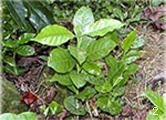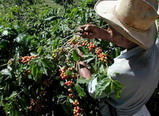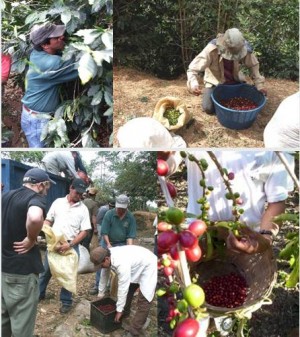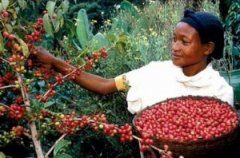A brief introduction to the Life process of Coffee beans
Coffee trees take 3-5 years from planting to fruiting. 6-10 Coffee trees bear fruit most easily in 15-20 years, which is the harvest period. Coffee trees are usually bred in nurseries, grown into saplings, and then moved to coffee plantations a year later, following exactly the same methods used by Arabs to grow coffee trees. For the first four or five years of its life, coffee trees take root downwards, grow upwards into trunks, and develop branches into umbrella-like shapes to bear rich fruit later on.
As coffee leaves become hotter when exposed to direct sunlight, their stomata close, unable to absorb carbon dioxide, and the coffee tree stops growing. Tall trees are planted next to coffee trees to avoid prolonged exposure to direct sunlight. They are usually tropical cash crops such as bananas and betel nuts. Bananas and other cash crops not only shade trees, but also through photosynthesis, produce carbohydrates for coffee tree growth energy. Because bananas grow fast and can be used as a by-product for economic income, it can be said that coffee and bananas are good brothers of tropical cash crops.
Coffee trees can only grow in tropical and subtropical regions, coffee trees in the "coffee belt" range of different climate, soil, altitude, rainfall can grow in the middle. The coffee tree thrives in Africa's hot, humid valleys and forest rainforests; it produces high-quality beans in cold, foggy, windy Central America; and it bears fruit in the Caribbean, where the climate varies from drought to torrential rain. These factors are the secret to the variety and variety of coffee beans.

1. Planting coffee beans 2. Coffee seedling cultivation 3. Coffee trees at the beginning of flowering
4. 5. Coffee flower maturity Coffee tree fruiting 6. Coffee berries ripen
One of the characteristics of the coffee tree is that its fruit can bear fruit several times a year. Another characteristic is that flowers and fruits (also known as cherries) coexist at different stages of maturity. The whole coffee crop is subject to the vagaries of nature. If the fruit is overripe, the beans inside will rot. If not ripe enough, the beans will not ripen themselves. So bean pickers often return to the same tree several times in search of ripe fruit-and they can only pick up 2 pounds on several trips. A typical Arabica coffee tree produces less than 5 kg/ 11 pounds of fruit a year, making about 1 kg/ 2.2 pounds of coffee beans.

7. Ripe coffee cherries 8. 9. Coffee fruit harvest Most coffee harvesting in the world is done by hand, so harvesting coffee is a labour-intensive and seasonally intensive process. Since both flowers and fruits are present on the same branch, the picker's index finger and thumb are the best tools for gathering ripe berries. Ripe berries cannot be distinguished from green berries either by scraping them off the entire branch by hand or by using automated harvesting machines.

Coffee farmers who produce low-grade coffee beans prefer to harvest the beans in a labor-saving way, but this reduces the coffee's flavor and grade because of its impure quality. In some parts of Africa, coffee beans are picked by shaking the coffee tree, shaking the fruit off the ground and picking it up before it hurts and rots. Most of Brazil produces secondary coffee, which is harvested by plucking all the leaves, flowers, overheated and green fruit from the branches at once. It takes two years for the damaged coffee trees to recover.
Automated Harvester Large-scale automated recovery process
When ripe red coffee "cherry" to become a coffee bean, it is necessary to go through a series of processing procedures, the next issue will introduce the processing process in detail.
Important Notice :
前街咖啡 FrontStreet Coffee has moved to new addredd:
FrontStreet Coffee Address: 315,Donghua East Road,GuangZhou
Tel:020 38364473
- Prev

The storm brand in the coffee cup is power.
In June of the second ○○, when the trademark case, which had been in dispute for two years, came to an end, Starbucks recognized that Ethiopia owned the trademarks of Sidamo, Yegashefi and Harald, and agreed to license the use of trademarks from Ethiopia, and agreed to assist Ethiopia in the marketing of coffee from these three areas. In November, President Howard Schultz (Howard Schultz) visited the provincial capital of Egypt and donated money to both sides.
- Next

A brief introduction to the processing methods of Coffee beans
Coffee bean processing when the hard bean farmers, will be ripe bright red coffee "cherry" pick down, coffee beans magical adventure will be launched. To convert a coffee fruit into a raw coffee bean, the peel and pulp of the coffee fruit need to be removed, leaving seeds or beans, and drying. This refining process usually has two main processing methods: washing (wet method) and drying.
Related
- Beginners will see the "Coffee pull flower" guide!
- What is the difference between ice blog purified milk and ordinary milk coffee?
- Why is the Philippines the largest producer of crops in Liberia?
- For coffee extraction, should the fine powder be retained?
- How does extracted espresso fill pressed powder? How much strength does it take to press the powder?
- How to make jasmine cold extract coffee? Is the jasmine + latte good?
- Will this little toy really make the coffee taste better? How does Lily Drip affect coffee extraction?
- Will the action of slapping the filter cup also affect coffee extraction?
- What's the difference between powder-to-water ratio and powder-to-liquid ratio?
- What is the Ethiopian local species? What does it have to do with Heirloom native species?

